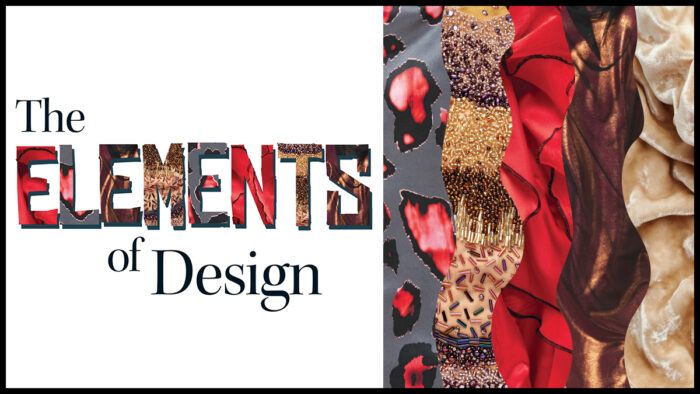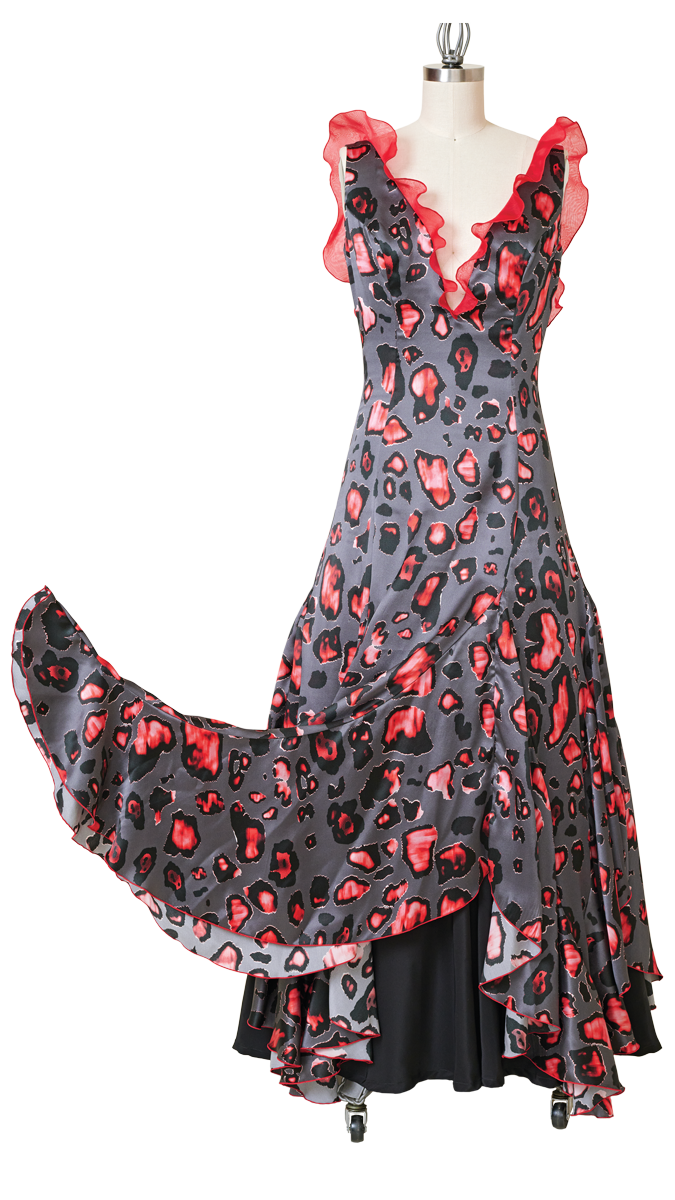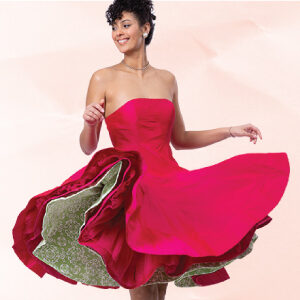Threads/ASDP: The Elements Challenge
Earth, air, water, and fire inspire high-glamour looks
In 2020, Threads editors posed a challenge to the members of the Association of Sewing and Design Professionals (ASDP): Create a garment or two-piece ensemble inspired by one of the four classical elements—earth, air, water, and fire. These elements have been associated with colors, shapes, seasons, the cardinal directions, gemstones, temperaments and humors, and animals. We requested that each look focus on one element, and interpret it in a way that was meaningful and well rendered.
A panel of judges reviewed the garments: Patty Robison, the 2019 challenge top winner (via remote connection); guest judge Anna Mazur, editor of Threads’ Pattern Review department; Threads Editorial Director Sarah McFarland; and me, Threads senior technical editor. We were intrigued by the range of approaches to the challenge and impressed by the high quality of all the garments. We selected four winning looks based on concept, design, and execution, and the association’s members voted for the Audience Choice award.
In the following pages, see how the talented winning designers met this challenge with imagination and expertise.
 |
Best Overall: Pat Billups
Volcanic Elegance
Pat is a first-time challenge winner, and is based in Grand Prairie, Texas. She chose the element of Earth as her inspiration, and focused on the creation of the planet’s land masses through volcanic activity. Her design, a flowing gown with a full skirt and low V-neckline, also alludes to the elements of air and fire, in the smoky and flamelike effects of the neckline frill.
The elegant silhouette was designed through flat-pattern techniques, which enabled Pat to integrate princess seams, gracefully shaped panels, and curved, two-piece godets that form a rippling hem. Her goal was to devise a conical shape that represents the contour of a volcano.
She selected a charmeuse fabric in a print that evokes lava pillows, then added a double-layer silk organza ruffle at the neckline. The stiff fabrication helps the ruffle stand up and hold an undulating shape that was created with a steam iron.
- The dress is lined in black silk charmeuse, which is revealed beneath the outer dress’s hemline. The lining is linked to the dress with thread chains at the top of each godet, to prevent the layers from twisting during wear.
- Pat fashioned a separate petticoat to support the skirt’s fullness. It is based on a pull-on shapewear girdle made of power mesh; this smooths the midsection under the clingy dress. Polyester tulle in two degrees of stiffness form the petticoat’s skirt.
- All the skirt and neckline ruffle edges are finished with a serged rolled hem, to provide a clean line with some body.

Finest Construction: Jennifer Phillips
Hidden Gems
Earth was also the inspiration for Jennifer, a custom dressmaker in Portland, Oregon. Her interpretation highlights the beauty of hidden geological and gemological treasures you can discover on our home planet. This ensemble is intended for a mother of the bride, and consists of a beautifully embellished sheath dress and short, fitted jacket. The jacket (not shown) and dress’s skirt are made of deep brown textured wool, reminiscent of healthy, rich soil.
The dress’s bodice, only partially visible when the jacket is worn, represents the “hidden gems,” and is densely covered with 25 bead types, all applied by hand. The jewel-tone beads conjure images of mountains and of geodes with a vein of gold. The bodice’s outer fabric is two layers of mocha-colored netting, supported by an inner structure of light beige tricot backed with flannel. A boned foundation with a waist stay and separate zipper are hidden within.
 |
 |
 |
- The dress is based on Vogue 8849 (out of print), a sheath style with a waistline seam and darted bodice. The jacket was adapted from Vogue 7963 (out of print), and has a wide neckline, rolled collar, and three-quarter-length sleeves.
- The dress is lined in silk, and the seam allowances are bound with silk organza to prevent the raw edges from fraying.
- The jacket closes with hidden snaps; the dress has an invisible zipper at the center back.
 Most Interesting Interpretation: Debby Spence
Most Interesting Interpretation: Debby Spence
Stalagmite Dress
Debby of Lancaster, Pennsylvania, has many Threads/ASDP challenge wins under her belt. This year, she approached the brief by considering the element of water—water whose flow is recorded by the mineral buildup that forms stalagmites.
The gown Debby designed reflects a stalagmite’s color, shape, and texture, through many fabric layers in pale, natural tones. The fabrics, some of which were from her stash, were chosen for their drape and texture. The bodice, which is gathered into the high collar, was copied from an out-of-print pattern. The rest of the dress was draped or drafted, to create the tapered, columnar silhouette.
|
|
|
The judges were impressed by the complex fabric layering, which accurately suggests the mineral deposits that, over millennia, result in a stalagmite. The finished gown is majestic, elegant, and even a bit avant-garde.
- The crushed velvet neckline section is hand-smocked in a random
pattern to create fluid folds. - Cream-colored four-ply silk was chosen as a lining for its heavy drape and strength. Most of the fashion fabrics are stitched to the lining.
- The dress has a left-side invisible zipper and hook-and-eye closures at the collar and shoulder.

Most Innovative Construction: Barbie McCormick
Smoking Hot Pink
Fire was the element that Barbie of Nampa, Idaho, opted to represent, and she kept her rendition minimalist but highly effective. Her garment is a two-layered, semifitted pullover cocktail dress. The inner layer is spandex knit in hot pink with an iridescent orange coating on the right side; the outer layer is soft black mesh knit. The judges appreciated how closely the layered textiles resemble the shifting colors of glowing embers encircled with smoke.
 |
What is most intriguing in this garment is Barbie’s construction technique: Fittingly for a piece inspired by fire, she used a hot knife to cut, melt, and fuse all the dress’s seams. She basted the seams, with right sides together, then cut off the seam allowances with a hot knife. Because the fabrics are synthetic, they fused in a fine line.
- The dress pattern was drafted from a basic sloper, and includes French darts and vertical back waist darts.
- A low neckline and stretch fabrics preclude the need for closures in this simple design.
- The overlay has a softly draped cowl neckline and a high-low hem for interest.

Audience Choice: April Jackson
Consumed
April of London, Ontario, Canada, also chose to design a garment portraying the element of fire. Just as fire can consume an object, this project consumed April’s creativity and thoughts for months. The result is a stunning ball gown that elicited admiration from the ASDP membership, who voted for the Audience Choice award, as well as from the guest judges and Threads staff.
This dress is made of red satin, with a plethora of embellishments that capture the gleam and movement of flames. April modified a basic ball gown design to have a one-shoulder bodice and a full skirt, supported by a petticoat. Beads, crystal trim, lace , and feathers adorn the bodice and skirt.
 |
- A linear crystal trim is couched in parallel, curving lines across the bodice. April used the MadamSew beading presser foot (#11) to
attach this embellishment. - The designer appliquéd three-dimensional lace with floral motifs and beads on the bodice front and back.
- Spiral flounces made of satin and organza flow down the skirt. Black overlock stitching on the flounces’ edges and black-tipped red feathers at the shoulder and hip suggest singeing.
Carol J. Fresia is Threads liaison with the ASDP.
 View the full article by clicking View PDF below:
View the full article by clicking View PDF below:







































What I'm dying to know is where Pat Billups found that amazing lava fabric! 😍
And if they make it in a knit!
I like the first two dresses and the last one. I don't think that the Water dress, No 3, is a good dress design. It may be very artistic - although the fact that it is actually the wrong shape for a stalactite isn't good, but it doesn't make a good dress.
The first fire dress doesn't work for me either, although that may mainly be because of the photograph which does not show the shimmer of the coloured fabric behind the black net. Also I don't think it would wear well in view of the way the seams have been cut and sealed with a hot knife. You'd probably have to keep sewing up the seams if you did much more than just stand around in it. Also I don't like the way the black net hangs below the hem of the inner fabrics.
Stalagmites rise from the floor of a cave, and taper toward the top--and Debby's dress successfully captured that silhouette as well as the layered effect. This site shows a photo with some stunning stalagmites: https://www.worldatlas.com/articles/the-different-types-of-stalagmite-formations.html
Carol Fresia, Threads Senior Technical Editor
Yes you're right, I obviously read stalactite for stalagmite - doh! Still don't much like the dress though.